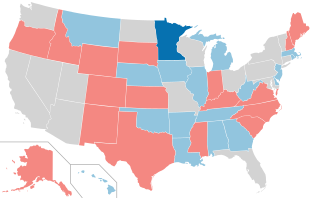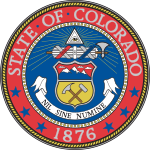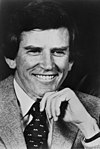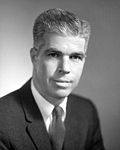
Gary Warren Hart is an American politician, diplomat, and lawyer. He was the front-runner for the 1988 Democratic presidential nomination until he dropped out amid revelations of extramarital affairs. He represented Colorado in the United States Senate from 1975 to 1987.

The 1990 United States Senate elections were held on Tuesday, November 6, 1990, with the 33 seats of Class 2 contested in regular elections. Special elections were also held to fill vacancies. The Democratic Party increased its majority with a net gain of one seat from the Republican Party. The election cycle took place in the middle of President George H. W. Bush's term, and, as with most other midterm elections, the party not holding the presidency gained seats in Congress.

The 1986 United States Senate elections were elections for the United States Senate. Held on November 4, in the middle of Ronald Reagan's second presidential term, the 34 seats of Class 3 were contested in regular elections. The Republicans had to defend an unusually large number of freshman Senate incumbents who had been elected on President Ronald Reagan's coattails in 1980. Democrats won a net of eight seats, defeating seven freshman incumbents, picking up two Republican-held open seats, and regaining control of the Senate for the first time since January 1981. This remains the most recent midterm election cycle in which the sitting president's party suffered net losses while still flipping a Senate seat.

The 1980 United States Senate elections were held on November 4, coinciding with Ronald Reagan's victory in the presidential election. The 34 Senate seats of Class 3 were contested in regular elections. Reagan's large margin of victory over incumbent Jimmy Carter gave a huge boost to Republican Senate candidates, allowing them to flip 12 Democratic seats and win control of the chamber for the first time since the end of the 83rd Congress in January 1955.

The 1974 United States Senate elections were held on November 5, with the 34 seats of Class 3 contested in regular elections. They occurred in the wake of the Watergate scandal, Richard M. Nixon's resignation from the presidency, and Gerald Ford's subsequent pardon of Nixon. Economic issues, specifically inflation and stagnation, were also a factor that contributed to Republican losses. As an immediate result of the November 1974 elections, Democrats made a net gain of three seats from the Republicans, as they defeated Republican incumbents in Colorado and Kentucky and picked up open seats in Florida and Vermont, while Republicans won the open seat in Nevada. Following the elections, at the beginning of the 94th U.S. Congress, the Democratic caucus controlled 60 seats, and the Republican caucus controlled 38 seats.

The 1972 United States Senate elections were held on November 7, with the 33 seats of Class 2 contested in regular elections. They coincided with the landslide re-election of Republican President Richard Nixon. Despite Nixon's landslide victory, Democrats increased their majority by two seats. The Democrats picked up open seats in Kentucky and South Dakota, and defeated four incumbent senators: Gordon Allott of Colorado, J. Caleb Boggs of Delaware, Jack Miller of Iowa, and Margaret Chase Smith of Maine. The Republicans picked up open seats in New Mexico, North Carolina, and Oklahoma, and defeated one incumbent, William B. Spong Jr. of Virginia.

The 1968 United States Senate elections were elections for the United States Senate. Held on November 5, the 34 seats of Class 3 were contested in regular elections. They coincided with the presidential election of the same year. The Republicans picked up five net seats in the Senate. This saw Republicans win a Senate seat in Florida for the first time since Reconstruction.

The 1932 United States Senate elections coincided with Democrat Franklin D. Roosevelt's landslide victory over incumbent Herbert Hoover in the presidential election. The 32 seats of Class 3 were contested in regular elections, and special elections were held to fill vacancies.

The 2010 United States Senate election in Colorado took place on November 2, 2010, alongside other elections to the United States Senate in other states as well as elections to the United States House of Representatives and various state and local elections. In December 2008, President-elect Barack Obama nominated incumbent U.S. Senator Ken Salazar as Secretary of the Interior. After Salazar resigned from his seat, Democratic governor Bill Ritter appointed Denver Public Schools Superintendent Michael Bennet to fill the seat.

The 1980 United States Senate election in Colorado was held on November 4, 1980. Incumbent Democratic U.S. Senator Gary Hart won re-election to a second term despite Republican nominee Ronald Reagan winning the state over Democratic President Jimmy Carter in the concurrent presidential election. This election was the first time since 1948 that an incumbent Democratic Senator from Colorado was re-elected or won re-election and the first time since 1938 that an incumbent Democratic Senator from Colorado was re-elected or won re-election for this seat.

The 1976 United States Senate election in New York was held on November 2, 1976. Incumbent Republican U.S. Senator James L. Buckley ran for re-election to a second term, but was defeated by Democratic diplomat Pat Moynihan. As of 2024, this is the last time an incumbent Senator from New York lost re-election to this seat.

The 1974 United States Senate election in Alaska took place on November 5, 1974. Incumbent Democratic U.S. Senator Mike Gravel was re-elected to a second term in office, defeating Republican State Senator Clyde "C.R." Lewis. This is the last time that a member of the Democratic Party has won the Class 3 Senate seat in Alaska. It is also the last time a person not named Murkowski has won this seat. Democrats did not win another Alaska U.S. Senate race until 2008.

The 1958 United States Senate election in Michigan was held on November 4, 1958.

The 1974 United States Senate election in Maryland was held on November 5, 1974, to elect one of Maryland's members to the United States Senate. Incumbent Republican U.S. Senator Charles Mathias Jr. won re-election to a second term defeating Baltimore City Councilwoman Barbara Mikulski, who won the Senate election 12 years later for this same seat upon Mathias' retirement.

The 2020 United States Senate election in Colorado was held on November 3, 2020, to elect a member of the United States Senate to represent the State of Colorado, concurrently with the 2020 U.S. presidential election, as well as other elections to the United States Senate, elections to the United States House of Representatives and various state and local elections.

The 1968 United States Senate election in Georgia took place on November 5, 1968. Incumbent Democratic U.S. Senator Herman Talmadge was re-elected to a third consecutive term in office, winning large victories in the primary and general elections.

The 1972 United States Senate election in Arkansas took place on November 7, 1972. Incumbent U.S. Senator John L. McClellan was re-elected to a sixth term in office, defeating U.S. Representative David Pryor in a hotly contested primary. In the general election, McClellan easily defeated Republican physician Wayne Babbitt. This was McClellan's final campaign; he died in his sleep in 1977. Pryor was elected Governor of Arkansas in 1974 and won the race to succeed McClellan in 1978.

The 1972 United States Senate election in Colorado took place on November 7, 1972. Incumbent Republican U.S. Senator Gordon Allott ran for re-election to a fourth term, but was narrowly defeated by Democratic former State Representative Floyd Haskell. This would be the last time until 2008 that a Democrat was elected to the Class 2 Senate seat from Colorado. Colorado was one of fifteen states alongside Alabama, Arkansas, Delaware, Georgia, Iowa, Louisiana, Maine, Minnesota, Mississippi, Montana, New Hampshire, Rhode Island, South Dakota and West Virginia that were won by Republican president Richard Nixon in 1972 that elected Democrats to the United States Senate.

The 1972 United States Senate election in Minnesota took place on November 7, 1972. Incumbent Democratic U.S. Senator Walter Mondale won re-election. Minnesota was one of fifteen states alongside Alabama, Arkansas, Colorado, Delaware, Georgia, Iowa, Louisiana, Maine, Mississippi, Montana, New Hampshire, Rhode Island, South Dakota and West Virginia that were won by Republican President Richard Nixon in 1972 that elected Democrats to the United States Senate.

The 1974 United States Senate election in Georgia took place on November 5, 1974. Incumbent Democratic U.S. Senator Herman Talmadge was re-elected to a fourth consecutive term in office, winning large victories in the primary and general elections.























